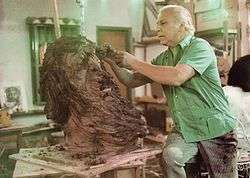Nicky Imber
Nicky Imber (1920–1996) was a multidisciplinary Jewish artist best known for his sculptures on Jewish themes.

After escaping the Nazi concentration camp in Dachau,[1] he pledged to dedicate his art to perpetuating the memory of the Holocaust. Among his more famous works are "The Hope" and "The Love of Torah." His work can be seen around the world, in Northern Israel, the Vatican, the United States, and the Venezuela Children's Prehistoric Park.
Biography
Nicky Imber was born in Vienna, Austria. During his studies at the Academy of Arts in Vienna, he drew anti-Nazi caricatures for Jewish student publications.[2] After several thwarted attempts by the family to leave Vienna, Imber's mother escaped to Shanghai. In 1938, in the wake of the 'Anschluss', Imber was deported to Dachau.[1] Witnessing the murders of family and friends, he plotted his escape. Using skills he had learned in art school, he made a face mask out of bread and sand, stole a Nazi soldier's uniform and walked out the front gate unnoticed.[3] In 1940, he boarded a ship headed to a Haifa. The ship's passengers were refused entry by the British mandatory authorities and imprisoned in a detention camp in Mauritius.[2]
In 1943, Imber worked out a deal with the authorities for his release by joining the British Army, serving as a war artist and a dental assistant in East Africa. After the war, he opened an art school in Nairobi, Kenya, and worked as a photographer and a safari guide.[2]
In 1949 to 1954, he lived in Venezuela, where he was contracted to do an East African Diorama series. The National Museum added an entire wing to display it.[4]
In 1959, Imber was commissioned to create sculptures and dioramas for the Haifa Prehistory Museum at Gan Ha-em in Haifa, Israel. In 1960 he returned to Venezuela to do the Phelps series of Dioramas for the Museum in Caracas.[4][5]

Between 1961 and 1971 he travelled extensively around Europe and after establishing an international name for himself, returned to the United States. In New York he became famous for his realistic oil paintings of portraits of Aga Khan, Tyrone Power, Ava Gardner, David Ben-Gurion, Golda Meir, Sir Richard Burton and Simon Bolivar.[6]
Returning to Venezuela in 1976, Imber created huge sculptures of prehistoric animals, forming one of the world's largest historical animal parks. During this period he also created realistic sculptures of famous Venezuelans for the country's National Hall of Fame.[7]
In 1978, Imber spent three years designing and building a Holocaust memorial park at the entrance to the city of Karmiel located in the Galilee, entitled 'From Holocaust to Resurrection.'[2] Imber also established animal theme playgrounds around the city.
In the 1980s, Imber (who is a grand-nephew of Naphtali Herz Imber, author of the Israeli national anthem 'Hatikva' – 'The Hope') established residence in Israel. In Israel he was inspired to create highly emotional, life like collections.
In 1988, Imber was chosen over hundreds of other sculptors by the Vatican to do restoration work on a 3,000-year-old Greek sculpture, and being commissioned to do replications of it.[8] Consequently, the Vatican selected him to restore Michelangelo's famous 'David' sculpture, after it was vandalized in 1992.[9]
Imber died in 1996 in Vienna, Austria.
See also
References
- 1 2 The Daily Journal Friday September 22, 1972
- 1 2 3 4 Meir Hareuveni, Ma'ariv newspaper, September 22, 1981
- ↑ Letter from Carmiel,1981 Yad Vashem Archives
- 1 2 Ve Venezuela Vol.2 No.56 April–May 1975
- ↑ Münstersche Zeitung Friday August 22, 1980
- ↑ The Sun Reporter Tuesday July 31, 1973
- ↑ El Nacional, Caracas, Thursday, April 22, 1976
- ↑ Iton Ha'ir Tzafon Newspaper April 1, 1988
- ↑ "a man the police described as deranged broke part of a toe with a hammer, saying a 16th century Venetian painter's model ordered him to do so." Cowell, Alan. "Michelangelo's David Is Damaged". New York Times, 1991-09-15. Retrieved on 2008-05-23
External links
- Official website
- Diana Lerner, Imberman dream of "City of Dreams", Ma'ariv, December 24, 1959